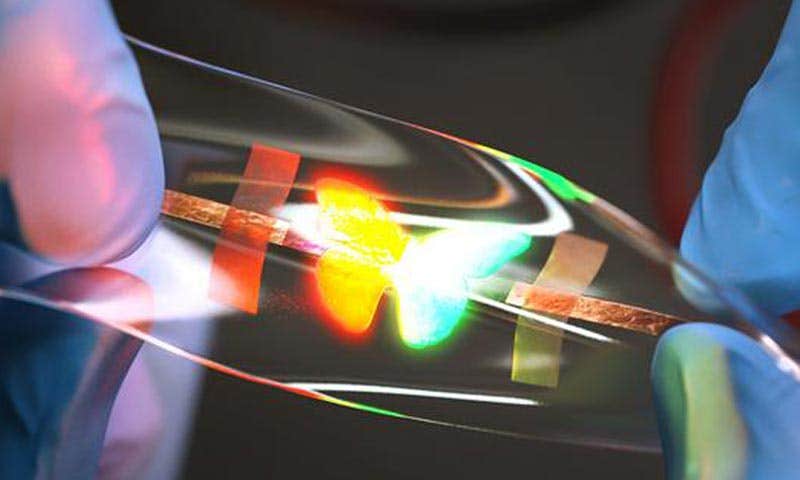Scientists create first-ever stretchable quantum dot television display
Their innovation marks the first development of intrinsically stretchable quantum dot light-emitting diodes (QLEDs).

Their innovation marks the first development of intrinsically stretchable quantum dot light-emitting diodes (QLEDs). (CREDIT: Institute for Basic Science)
A team of South Korean scientists, led by Professor KIM Dae-Hyeong from the Center for Nanoparticle Research within the Institute for Basic Science, has introduced a groundbreaking advancement in stretchable displays. Their innovation marks the first development of intrinsically stretchable quantum dot light-emitting diodes (QLEDs).
In the ever-evolving realm of display technologies, the pursuit of creating intrinsically stretchable displays has persisted. Traditional displays, bound by rigid components, have struggled to advance beyond flexible ones.
Novel materials and device designs capable of enduring significant stretching while retaining functionality are crucial for applications like wearable and adaptable interfacing technologies.
Demonstrations of intrinsically stretchable quantum dot light-emitting diodes. The intrinsically stretchable QLEDs have a device structure where all the layers were engineered to have a sufficient level of stretchability. The stretchable QLEDs could be stretched to 50% with consistent device performance. Also, a passive matrix and full-color QLEDs were demonstrated. (CREDIT: Institute for Basic Science)
Most flexible displays on the market use organic light-emitting diode (OLED) technology, employing organic materials as light-emitting components. However, OLEDs often suffer from limited brightness and color purity issues. In contrast, QLED displays offer superior color reproduction, brightness, and longevity, making them attractive to consumers who prioritize these factors.
Yet, the inherent challenge in developing flexible QLED displays stems from the nature of quantum dots (QDs) themselves. As zero-dimensional inorganic nanoparticles, QDs lack inherent stretchability.
Previous attempts to embed QDs within elastic materials encountered hurdles, notably the elastomers' insulating properties hindering efficient electron and hole injection into the QDs, thus diminishing electroluminescent efficiency.
Related Stories
To address these challenges, the IBS researchers introduced innovations to enhance carrier delivery to the QDs. They incorporated a third material into the composite, employing a p-type semiconducting polymer, TFB, to improve stretchability and hole injection efficiency while achieving a better balance between electron and hole injections.
An intriguing feature of the ternary nanocomposite film was its unique internal structure, displaying phase separation with TFB-rich "islands" at the base and QDs embedded in the SEBS-g-MA matrix atop these islands.
This structural arrangement minimized exciton quenching sites and improved hole injection efficiency, resulting in optimal device performance.
Following meticulous material selection and engineering, the researchers achieved QLEDs with high brightness (15,170 cd m-2), the highest among stretchable LEDs, and a low threshold voltage (3.2 V).
The device maintained integrity even under significant stretching, with no significant change in the distance between quantum dots when stretched up to 1.5 times. This implies that if a 20-inch QLED TV were made using this technology, its display performance would remain consistent even when stretched to a 30-inch size.
Co-first author Professor KIM Dong-chan noted, "Our research team also developed a high-resolution patterning technology applicable to stretchable quantum dot light-emitting layers," highlighting the potential for RGB LEDs and complex applications like passive matrix arrays by combining light-emitting materials and patterning technology.
QD-based stretchable emission layer for intrinsically stretchable quantum dot light-emitting diodes. Schematic illustration of is-QLED based on the intrinsically stretchable emission layer. (CREDIT: Institute for Basic Science)
This research not only showcases the superior performance of QDs in stretchable displays but also charts a new course for further enhancing device performance. Future research aims to optimize carrier injection efficiency and stretchability across all device layers.
This discovery lays a solid foundation for the next generation of stretchable QLED technology, promising a future where display technologies are not only flexible but truly stretchable, unlocking new possibilities for wearable electronics and beyond.
This research has been conducted in collaboration with colleagues from Seoul National University, Ulsan National Institute of Science and Technology, and Daegu Gyeongbuk Institute of Science and Technology. It was published in Nature Electronics.
For more science news stories check out our New Innovations section at The Brighter Side of News.
Note: Materials provided above by Aalto University. Content may be edited for style and length.
Like these kind of feel good stories? Get the Brighter Side of News' newsletter.
Tags: #New_Innovations, #Computers, #Displays, #Gold, #DNA, #Technology, #Research, #Light, #The_Brighter_Side_of_News
Joshua Shavit
Science & Technology Writer | AI and Robotics Reporter
Joshua Shavit is a Los Angeles-based science and technology writer with a passion for exploring the breakthroughs shaping the future. As a contributor to The Brighter Side of News, he focuses on positive and transformative advancements in AI, technology, physics, engineering, robotics and space science. Joshua is currently working towards a Bachelor of Science in Business Administration at the University of California, Berkeley. He combines his academic background with a talent for storytelling, making complex scientific discoveries engaging and accessible. His work highlights the innovators behind the ideas, bringing readers closer to the people driving progress.



